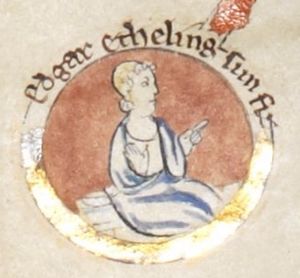Ætheling facts for kids
An Ætheling (pronounced ATH-uh-ling) was an important title in Anglo-Saxon England. It was an Old English word used to describe princes from the royal family who were allowed to become king.
The word ætheling comes from Old English and Old Saxon words. Aethele or æþele means "noble family," and -ing means "belonging to." So, an Ætheling was someone who belonged to a noble, royal family. In Latin, people often called them filius regis, which means "king's son."
You can still find the word Ætheling in some place names today, like Athelington in Suffolk, England.
What Ætheling Meant in Anglo-Saxon England
In the very early days of Anglo-Saxon rule in England, the word ætheling probably referred to any person who was born into a noble family. But soon, its use became more specific. It was only used for members of the royal family.
Many Anglo-Saxon kings had names that started with Æthel-, like Æthelberht of Kent, Æthelwulf of Wessex, and Æthelred of Wessex. This part of their name showed that they were of noble birth.
According to a document from the 10th century, an Ætheling's life was considered very valuable. Their "weregild" (a payment made to the family of someone who was killed) was set at 15,000 thrymsas. This was equal to the value of an archbishop and half the value of a king!

By the 9th century, the term ætheling became even more specific. It was used only for members of the House of Wessex, which was the ruling family. Most often, it referred to the sons or brothers of the king who was currently ruling.
Historian Richard Abels explains that King Alfred changed how kings were chosen. Before Alfred, any nobleman with a royal ancestor, even a distant one, could try to become king. After Alfred, only the sons and brothers of the current king were considered worthy of the throne.
Later, during the reign of Edward the Confessor, Edgar the Ætheling was given this title. He was the grandson of Edmund Ironside. This happened because, for the first time in 250 years, there wasn't a living Ætheling who fit the strict definition (a son or brother of the king).

The word ætheling was also used in poetry. In poems, it could simply mean "a good and noble man." Old English poems often used ætheling to describe Christ, as well as important prophets and saints. The hero of the 8th-century poem Beowulf is introduced as an ætheling. This might mean he was a relative of the King of the Geats. Some people translate ætheling in this context as "retainer" or "follower." In ancient Scandinavia, kings were often chosen by competition or voting, not just by being the oldest son. So, the term might have been used for someone who was qualified to compete for the kingship.
Other Uses and Related Terms
Even after the Norman conquest of England in 1066, the term ætheling was sometimes used. It was still used to describe members of the royal family. For example, William Adelin was the only legitimate son and heir of Henry I of England. His name used a Latinized Germanic form, Adelinus, which came from Ætheling. Sadly, he drowned in the White Ship disaster in 1120.
The term was also sometimes translated into Latin as clito, as seen in the name of William Clito. This word might have come from the Latin word inclitus, meaning "celebrated."
Historian Dáibhí Ó Cróinín suggests that the idea of the rígdomna in early medieval Ireland came from the Anglo-Saxon idea of the ætheling. A rígdomna was a prince who was next in line for the throne. The earliest use of tanaíste ríg (another term for a king-in-waiting) was actually about an Anglo-Saxon prince around the year 628. Later, this term was used for Irish kings-in-waiting.
In Wales, a similar word, edling, was used. It meant the son who was chosen to be the heir apparent, or the next person to inherit the throne.
See also
- Aþel
- Ebeling
- Ethel

